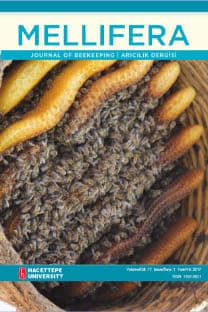The determination of a parasite of honey bee (Apis mellifer L.) ''Nosema apis z. ''in Honey
Özet: Bu çalışmanın amacı Türkiye 'nin farklı bölgelerinden elde edilmiş olan ballardaki Nosema apis oranını belirlemektir. Bal örnekleri farklı bölgelerden, farklı zaman aralıklarında toplanmıştır. 1 gr bal homojenize edilmiş ve 1 mi steril distile su eklenmiştir. Daha sonra bu solüsyonun 0,1 misi Neubauer lamı üzerine alınmış ve Nosema apis sporları sayılmıştır. Sonuçlar, bal örneklerinin %4'ünün enfekte olmamasına rağmen, %96'sının Nosema apis sporları ile enfekte olduğunu göstermiştir. Böylelikle Türkiye'deki Nosema apis enfeksiyonunun balda bulunmaması gerekmesine rağmen, dağılımı ve yoğunluğu saptanmış ve balda çok büyük miktarlarda bulunduğu görülmüştür. N. apis sporları içeren balla beslenmek, sağlık açısından yararlar ve riskler içermektedir.
Bal Arısı (Apis mellifera L.) paraziti olan ''Nosema apis''in balda saptanması
Summary: The aim of the study is to find out the ratio ofNosema apis infected honey from different regions of Turkey. Honey samples were collected from different regions in different periods. 1 gr honey was homojenized and 1 ml sterilled distelled water was added. Than, 0.1 ml out of this solution was examined by Neubauer slide and the number ofNosema apis spores were counted. The results showed that 96% of honeys were infected by Nosema apis spores, although 4% of honey samples were noninfected. Thus, the extent of the spread and density of Nosema apis infection in Turkey is revealed by the fact that the spores reach even to honey and they present in huge numbers in honey. To be nourished with honey, including N. apis spores, involves both benefits and risks to health.
___
- 1.Jeddar A., Kharsany A., Ramsaroop V.G., Bhamjee A., Hafejee I.E., Moosa A., The Antibacterial action of Honey, South African Medical Journal, 257-258, 1985.
- 2.Molan P.C., The Antibacterial activity of Honey. Bee World, 73, 5-28, 1992.
- 3.Fries I., Nosema apis- A parasite in honey bee colony. Bee World, 74(1), 5-19, 1993.
- 4.Allen M.F., Ball B.V., The Incidence and World Distribution of Honey Bee Parasites. Bee World, 77 (3), 141-162, 1999.
- 5.Shimanuki H., Knox, D.A., Diagnosis of Honey Bee Diseases, 1-56 pp., Department of Agriculture, Agriculture HandBookNo. AH.690 U.S.D.A, 1991.
- 6.Fries I., Infectivity and Multiplication of ventriculus of Honey Bee. Apidologie, 19, 319-328, 1988.
- 7.Wyborn M.H., Cutchean M.D., Comparison of dry and wet fumagillin treatments for spring Nosema disease suppression of overwintered colonies. American Bee Journal, 127, 207-209, 1987.
- 8.Bermejo F.J.O., Fernandez P.G., Nosema Disease in Honey Bee (Apis mellifera L.) infested with Varroa Mites in Southern Spain. Apidologie, 28, 105-112, 1997.
- 9.Molan PC, Russel K.m., Non-peroxide antibacterial activity in some New-Zealand Honeys. Journal of Apicultural Research, 27(1), 62-67, 1988.
- 10.Weston R.J., The Contribution of Catalase and other natural products to the antibacterial activity of Honey. A review Food Chemistry, 71, 235-239, 2000.
- 11.Sokal R.R., Rholf F.C., Biometry Freeman, l-928pp., Publ. San Francisco CA, 1981.
- ISSN: 1302-5821
- Başlangıç: 2001
- Yayıncı: Hacettepe Üniversitesi
Sayıdaki Diğer Makaleler
The determination of a parasite of honey bee (Apis mellifer L.) ''Nosema apis z. ''in Honey
Aslı ÖZKIRIM, Nevin KESKİN, Kadriye SORKUN
Experimental study of bee royal jelly cardioprotective characteristics
Vasily N. KRYLOV, S.S. SOKOLSKY, E.V. KRYLOVA
Protein analysis with kjeldahl of pollen grains collected by Apis mellifera L.
Aslı Özkök TÜYLÜ, Kadriye SORKUN
A phenological calendar of pollens collected by Apis mellifera L.
Pollen analysis of Honeys from Hendek-Akyazı and Kocaali districts of Adapazarı province (Turkey)
